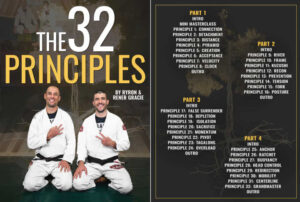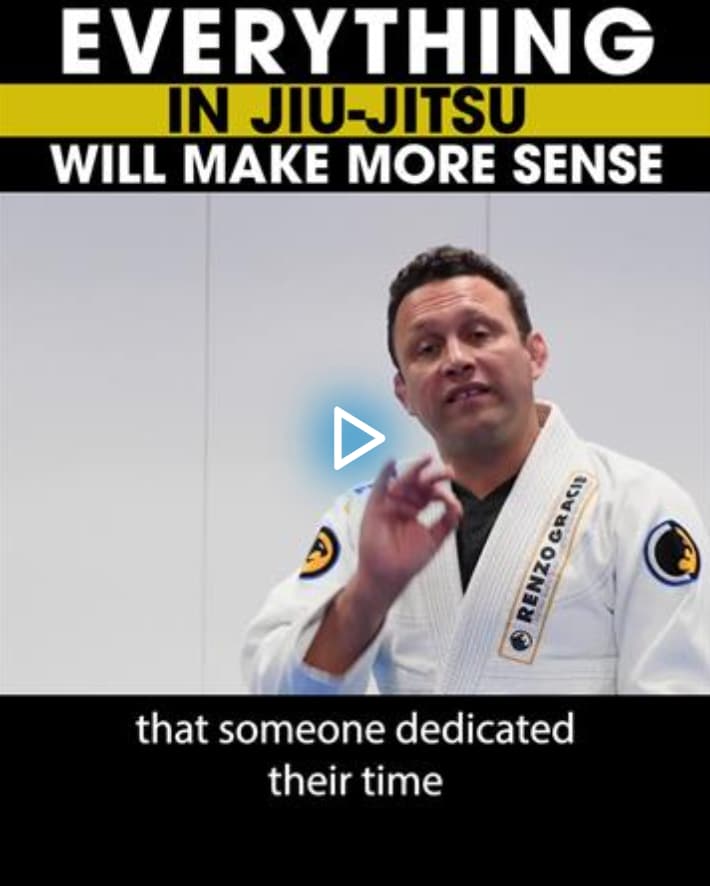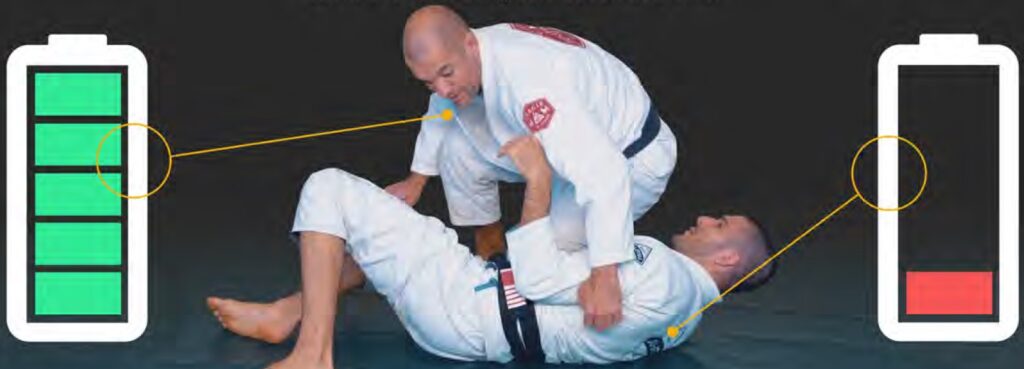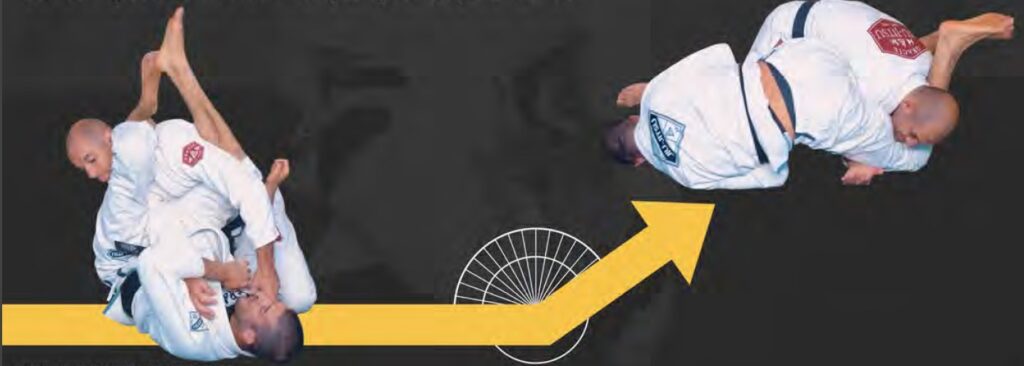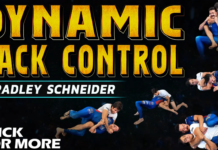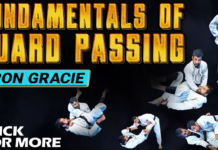
Do you want to learn Brazilian Jiu-Jitsu faster and become a really fast-learning Jiu-Jitsu practitioner? You have two options. First, start “living” in a gym. You’ve seen the results of the DDS, and you’ve seen the same happening to the Daisy Fresh crew. Too much for you? Your second option is to look into what other people in the BJJ community did to get their black belts in record time while learning how to grapple effectively (like Kit Dale). Start learning the principles that make Jiu-Jitsu work, instead of just techniques. Now, through Gracie University, run by Rener and Ryron Gracie, you can achieve exactly that. Check out their 32 Principles of Jiu-Jitsu Program, an instructional like no other! You’ll learn about core principles and fundamentals every Jiu-Jitsu practitioner should know.
What Is The Gracie University?
The Gracie University is an online program established by brothers Rener and Ryron Gracie, sons of Rorion Gracie. They created the first online training environment for learning Brazilian Jiu-Jitsu and named it Gracie University.
The online program offers an in-depth curriculum that takes students from white to black belt, without them having to be a part of a gym. However, it goes beyond just providing videos and awarding belts for cash. The University has belt testing, done at certified training centers by certified instructors. There’s also an option for students to upload a video of them performing techniques with a partner and get feedback from instructors.
Apart from curriculums for every belt level, there are also specialized programs available through the platform. These include Gracie Bullyproof, Women Empowered, Gracie Combatives, Street Choke Mastery, Rules Of Engagement, Junior Combatives, and others.
The Gracie University platform also has forums and outlines all affiliated gyms, making it easy to connect with other members. Rener and Ryron Gracie also upload weekly narrated sparring videos for registered students.
Who Are Rener and Ryron Gracie?
The original Gracie gym in the USA was the Torrance Gracie Academy in California. It was established by Rorion, Rickson, and Royler Gracie in 1989. Rener and Ryron Gracie are Roruion’s sons, and they have taken the gym to new heights after they took over from their father in the early 2000s.
Ryron Gracie is the older of the two brothers, born in 1981. He was promoted to black belt by his grandfather Helio Gracie and has been training Jiu-Jitsu since he could walk. He has several titles in Gracie Tournaments, which were huge in the early 2000s.
Rener Gracie, born in 1983 is also a Helio Gracie black belt. He completed a lot for a couple of years after receiving a black belt, winning the Southern California Pro-Am Invitational 16-man tournament in 2004 by submitting all of his opponents. He decided to focus more on teaching Jiu-Jitsu for self-defense rather than competing in point-based tournaments.
What are The “32 Principles Of Jiu-Jitsu” Program About?
One of the specialized Gracie University programs, now also available through BJJ Fanatics is the “32 Principles of Jiu-Jitsu Program”. It is a different take on learning Jiu-Jitsu, one that Rener and Ryron Gracie claim is unique and never before shown.
To be honest, there’s a lot of talk about techniques-based teaching/learning versus principle-based teaching/learning in Jiu-Jitsu. So far, not many people have attempted to produce content that can help understand the principle-based approach. Furthermore, only a few of those have, actually offer something of worth.
The 32 Principles of Jiu-Jitsu Program” is put together in a way that guarantees you will be able to immediately apply the principles to what you do in class. yes, you will still need to go to class, spar, and all that stuff. However, with principles in mind, instead of techniques, you’ll be able to move up the belt ranks much faster. At least that is the claim.
Learn BJJ Faster
In Brazilian Jiu-Jitsu, there is nobody that can name all the moves. There are so many moves, and people name so many stuff on a daily basis that it is impossible to track. After all, the entire martial art itself started off with a blend of Japanese and Portuguese terms, which were quickly joined by American phrases and terms. Add to that the local language of wherever BJJ is being taught, and then you have the Esperanto of martial arts – a common language that nobody can really speak in its entirety.
In order to actually learn Jiu-Jitsu, you’ll need to make sense of everything. The best way is to try and understand why things happen, how things happen, and when things happen. Simple right? Not so fast.
In order to be able to understand things, you will need structure. Otherwise, you’ll be just as lost as trying to follow a roll-o-deck of techniques. To that extent, a program that focuses on micro principles, like the one by Rener and Ryron Gracie offers the best of both worlds – principles you can apply across the board, along with an organizational system of learning them.
Principles vs. Techniques
This is a debate that I declare a draw. Change my mind. The fact of the matter is, you need both. If you avoid thinking in terms of one or the other, you can actually get the best out of both worlds. Namely, principles explain why techniques work, when to use them, and how to set them up in order to be able to execute them. Techniques, on the other hand, are the nuts and bolts – no matter how much theory you have, you can’t build something without the materials.
As I previously mentioned, most people have issues with technical instruction. Very few opt for the much more difficult thing and try their hand at principle-based instruction. Many (from both ends of the spectrum) fail. So far, nobody has attempted to show the BJJ world how to join both ends of the spectrum in order to “become enlightened” quickly.
Joking aside, Gracie University now promises to solve a big part of this riddle via its “32 Principles of Jiu-Jitsu Program”.
Reducing The Clutter
There are just too many things available in BJJ. A huge reason why coaches always tell their students to specialize or focus on “this” or “that” is an attempt to keep students from getting lost in the vast universe of grappling.
By focusing on principles, the clutter of moves, positions, and most importantly, their names will greatly decrease. All you have to worry about now is the gross aspects – are your top or bottom, passing, staying on top, submitting, escaping. Using common principles as guidelines, and the above-mentioned as a strong foundation for broad goals, you’ll quickly get the hang of this “BJJ thing”.
Better Teachers
But wait, that is not all! Principles will do as much, if not more, for teachers in Jiu-Jitsu than they will for students of the “Gentle Art”. Teaching based on principles will help coaches give more precise directions to their students by making them focus on the bigger picture. Yup, that’s right, focus on the big picture and you’ll figure out the details because you’ll know where they fit.
Dissecting The 32 Principles Of Jiu-Jitsu by Rener And Ryron Gracie
Ok, enough chit-chat. let’s take a look at all of the 32 Principles of Jiu-Jitsu by Rener and Ryron Gracie that promise to change our BJJ game the same way BJJ has changed our life.
1. Connection Principle
The connection principle refers to being as close to your partner as possible, both in terms of attacking and defending. A staple of many Gracie University programs, connection refers to creating movement, preventing movement, or predicting movement. All of these are possible because you’re able to feel even the tiniest shifts in your opponent’s body positioning by leaving no space between you and them.
Basically, all of the following principles are forms of connection with your opponent.
2. Detachment Principle
Achieving optimal efficiency in transitions through deliberate connections from your opponent. In other words, know when to let go in order to achieve a strategic goal. Holding on for dear life does not translate to better control.
3. Distance Principle
A true Gracie University staple, distance has the role of neutralizing the application of a technique against you by disrupting the optimal distance from which it is applied. What Rener and Ryron Gracie mean by this is that managing distance makes it impossible for the opponent to attack effectively. It will help you understand how to stay safe and attack more efficiently.
4. Pyramid Principle
Optimizing connections with the ground and with your opponent to maximize balance and control at all times. This one has to do with your center of gravity and being constantly aware of where it is in relation to both the ground and your opponent. The goal is to be like a pyramid, well-balanced and impervious to attack from every angle.
5. Creation Principle
Using targeted actions to force specific reactions in your favor is the core of the Creation Principle. This one is all about the art of counter-attacking in BJJ. Crate openings by making your opponents react in a predictable way. The principle is very interestingly presented by the brothers as “be first, and be third”.
6. Acceptance Principle
The acceptance Principle means being first to accept the inevitability of action so that you are best prepared for the outcome. Sometimes, you can’t do what you want, and the opponent will get their move (pass sweep, transition, etc.). let them, so that you can control the outcome rather than be forced into it.
7. Velocity Principle
Constantly changing your operational speed to confuse and overwhelm your opponent. Being fast all the time is predictable. So is being slow. Instead, break your rhythm and constantly change the speed at which you execute your moves. Alternating “fast and loose” and “slow and tight” is what they teach at Gracie University.
8. Clock Principle
Disrupting the anticipated timing of your opponent’s techniques to reduce or eliminate their effectiveness. If you understand what is happening, you can guess the timing of a move or technique, and do your best to stop it or capitalize on it using the “Creating” principle, for example.
9. River Principle
Bypassing resistance by flowing around it. Instead of trying to power through your opponent, go around them. If they’re focused on stopping one thing, go around like a river flows around a rock, and attack with something else.
10. Frame Principle
Substituting muscular strength with skeletal structure from every position in the fight. Rener and Ryron Gracie are great admirers of this particular principle. Instead of focusing on your muscles to do the work, use your entire body to achieve mechanical superiority, whether you’re looking to create space, or take it away.
11. Kuzushi Principle
Breaking your opponent’s balance in your favor. If there’s one thing that’s really important here it is the last part of the definition “in your favor”. Focus on deliberate, precise ways in which you can affect your opponent’s center of gravity, using the Pyramid principle against them.
12. Reconnaissance Principle
Gathering information about your opponent’s behavior for use against them. This is like a tactical strategy out of Sun Tzu’s “Art Of War”. What Rener and Ryron mean by it is that every exchange allows you to learn something about your opponent’s preferred approach to JIu-Jitsu. This is information you can use against them, preferably paired with the Clock principle.
13. Prevention Principle
Putting your opponent’s objectives before your own to prevent their progress. Often talked about in Gracie University videos of breakdowns, the 13th of the 32 Principles of Jiu-Jitsu addresses how to stop opponents from executing what they’re looking for. How? By provoking an overreaction that will open up a counter-attacking opportunity for yourself.
14. Tension Principle
Capitalizing on the offensive and defensive opportunities enabled by tension. When two points are connected, there is tension. keeping it or letting go of it can help you achieve your Jiu-Jitsu goal. It is all about determining which is the right course of action at a given moment.
15. Fork Principle
Creating positional dilemmas that force your opponent to choose how they lose. The “your money or your life principle”. Make your opponents choose the “least bad” option for them. For example, threatening with a sweep and submission at the same time.
16. Posture Principle
Neutralizing a technique by disrupting the optimal posture from where it is applied. Halfway through the 32 Principles of Jiu-Jitsu Program by Rener and Ryron Gracie, we have another huge staple of Gracie University BJJ – posture. Standing, sitting, or supine, posture plays a role – it is the alignment of your vertebrae. Break this alignment and you will make opponents significantly weaker.
17. False Surrender Principle
Feigning surrender so that your opponent lets their guard down. Not quite “the Brazilian Tap”. but not too far either. Pretending to accept a bad position or allow entry into a submission hold does not mean you’re actually giving up. Tricky, but very efficient and highly-reliable principle.
18. Depletion Principle
Draining your opponent’s physical and mental energy using targeted actions and connections. If two grapplers are equally skilled, conditioning will determine who wins. The depletion principle helps you exhaust opponents while staying fresh yourself. It involves using moves that save your energy while burning lots of your opponent’s energy at the same time.
19. Isolation Principle
Tactically contain one or more of your opponent’s limbs for your advantage. Simply put, Rener and Ryron Gracie here refers to restricting mobility by neutralizing a certain limb. You can use it to finish submissions, break through defenses, or control an opponent.
20. Sacrifice Principle
Give up something of actual or perceived value to gain a tactical advantage in another form. Unconventional, but then again, that is at the core of the Gracie University system. When you can’t seem to gain ground during a match, you’ll have to think in terms of chess- lose a battle o win the war. Be careful not to give up too much though, or this principle could backfire!
21. Momentum Principle
Capitalizing on mass in motion to maximize efficiency against your opponent. Either make the most of the momentum that is already there or create momentum in order to facilitate your own attacks/escapes.
22. Pivot Principle
Increase the effectiveness of a technique by changing the angle of its application. He who dominates the angle will dominate the fight. Pivoting helps you change angles in order to get the best one for executing a technique of your choice.
23. Tagalong Principle
Seizing the “free rides” in the fight saves your energy while depleting the opponents. Goes hand in hand with the Depletion principle. Basically, it is all about surfing on your opponent from the top or allowing them to pull you from the bottom in order to achieve a better position, and conserve energy.
24. Overload Principle
Disproportionate application of your resources to target a specific part of your opponent’s body. This one is something you already know – think of submissions like an armbar, for example. Your entire body against the elbow joint of the opponent’s arm. Well, Rener and Ryron Gracie now show how this principle is available in other situations and not just when finishing joint locks.
25. Anchor Principle
Pinning any part of your opponent’s body to a surface to inhibit mobility. This a principle that will require some work on your part to fully understand. It works in terms of pinning an opponent to a surface, yourself to a surface, you to yourself, the opponent to you, you to your opponent, and the opponent to themselves.
26. Ratchet Principle
Creating persistent incremental advancements in one direction while preventing motion in the opposite direction. Out of all the 32 principles of Jiu-Jitsu, this one is my favorite. Ratcheting can be done in a “micro-ratchet” or “macro-ratchet” fashion. The former refers to moving parts of your body, while the latter involves moving the entire body. The key moment is that once you move, you set up in a way that prevents the opponent from moving you back.
27. Buoyancy Principle
Capitalizing on offensive and defensive surfacing opportunities throughout the fight. What is buoyancy? it is the upward force that prevents an object from sinking into a fluid. In BJJ terms, this means successfully getting a top position when you’re on the bottom, or retaining a top position when you have it.
28. Head Control Principle
Controlling your opponent’s head to limit or direct their movement. Where the head looks, the body will follow. Explore the different ways in which twisting, turning, tilting, framing, hugging, pulling, pushing, or pinning the head can help you control an opponent. This principle has both offensive and defensive applications.
29. Redirection Principle
Reducing your opponent’s effectiveness by controlling the direction of their energy. Instead of fighting force with force, redirect your opponent by changing the angle or intercepting their energy.
30. Mobility Principle
Moving yourself when your opponent cannot be moved. Can you move a wall away from you by pushing it? How about moving yourself away from the wall, like doing a push-up? Recognizing when to move your opponent, and when to move yourself will make Jiu-Jitsu a lot easier for you.
31. Centerline Principle
Limiting your opponent’s potential by taking control of their centerline. By either “splitting” or “breaking” the opponent’s appendages, you can make them weak and susceptible to your attacks. Particularly useful when hunting submissions.
32. Grandmaster Principle
Using the 32 principles to continuously improve Jiu-Jitsu. Rener and Ryron Gracie wrap the 32 principles up with a story about how their grandfather Helio Gracie constantly adjusted and evolved BJJ to make it work for his frail body. Through their Gracie University programs core teachings, and the principles above they encourage everyone to do the same!
How To Use The Program
Ok, so Rener and Ryron outlined the principles in a series of instructionals and explained each and every one in detail. What now? How do you put so much information to practice?
The brothers have that covered as well in their instructional. They suggest working on the principles one by one, focusing on things you can recognize easily first. As you do that, the goal is to develop them like you would any other BJJ technique – look for them during sparring, and make sure that you can recognize them. In other words, pick a principle, and spend some time trying to find it everywhere while you are rolling. It is the quickest way to learn them all.
The entire 32 Principles of Jiu-Jitsu Program started off as part of the brown and black belt curriculum for the Gracie University online classes. However, the brothers quickly realized that everyone, particularly beginners could really benefit from the program so they adjusted it to fit all levels of BJJ practitioners.
How Much For The 32 Principles Of Jiu-JItsu Program?
The price of one piece of the 32 principles of Jiu-Jitsu is $74 if you’re willing to buy 8 out of the 32 principles. At BJJ Fanatics you can buy “The 32 Principles Of Jiu-Jitsu” with a 25% discount via a discount code.
In conclusion
Not many principle-based instructionals out there can really help you learn Jiu-Jitsu and make an impact on your game. This one can. Granted, it has lots and lots of information to go through, but it is basically Brazilian Jiu-Jitsu broken down completely into 32 lessons. Learning 32 things is a lot faster than mastering 32.000 techniques. Just saying.
The 32 principles of Jiu-Jitsu is on sale on BJJ Fanatics right now with a 25% discount so check it HERE.
